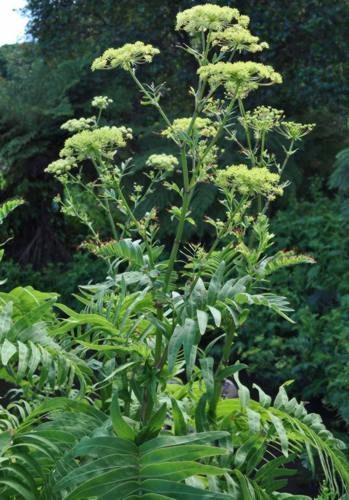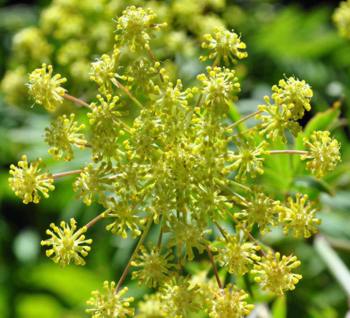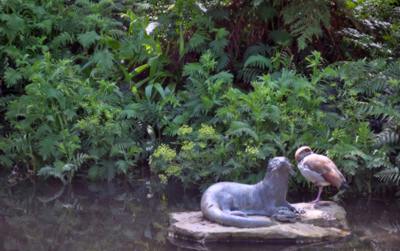Berula repanda
Berula repanda (Hiern) Spalik & S.R.Downie (= Sium repandum Hiern)
Family: Apiaceae
Common names: Water parsnip
Introduction
Berula repanda is a luxuriantly foliaged plant, ideal for a garden pond or wet patch, and it is in full flower now.

Description
Description
Berula repanda is an evergreen, rhizomatous perennial that grows up to 1.5 m tall. It has striking, simple, pinnate leaves which are marginally toothed and borne on hollow stems. The flowers are arranged in compound umbels and have creamish petals and numerous persistent involucral bracts. The fruit consist of two mericarps, each with 5 ridges and reddish-brown when ripe. It flowers predominantly from January to April during the warm summer months (Hiern 1896; Townsend 1989).

Conservation Status
Status
Berula repanda is treated as Least Concern (LC) in the Red List of South African Plants (Raimondo et al . 2009).
Distribution and habitat
Distribution description
This species is widely distributed from Cameroon and Tanzania southwards to Angola, Mozambique and South Africa, where it is locally common in wet areas along stream banks. (Townsend 1989).
Derivation of name and historical aspects
History
The genus Berula, until recently, comprised only a single species, B. erecta. However this concept was expanded by Spalik et al. (2009), to include the monotypic genus Afrocarum and three species previously placed in Sium. The genus now comprises six species, four of which are restricted to Africa (of which two are endemic to St Helena). The generic name is a distortion of another well known Apiaceae genus, Ferula, commonly called hog's fennel (Trinder-Smith, 2003). The specific name "repanda " refers to the slightly uneven and wavy leaf margins that distinguish it from the similar B. thunbergii.

Uses
Use
We are not aware of any cultural or medicinal uses for this species. However, Berula thunbergii is used traditionally to treat toothache and has been reported to be poisonous to livestock, while, in contrast, the stems of B. bracteata are eaten raw in St Helena (Watt & Breyer-Brandwijk 1962).

Growing Berula repanda
Grow
This plant needs to be grown in a very wet position preferably along the banks of a pond or potted up in the pond where they will tolerate full sun or semi-shade. As it grows from a creeping rhizome it can be propagated vegetatively by subdivision of the rhizome. This species is the dominant planting along the edge of the Otter Pond in Kirstenbosch Botanical Garden, Cape Town, where it can be seen growing together with Alsophila dregei (tree fern), Wachendorfia thrysiflora and Crocosmia x crocosmiiflora.
References
- Hiern, W.P. (1896). Catalogue of the African plants collected by Dr. Friedrich Welwitsch in 1853-1861. Dicotyledons. Volume 1, Part 1. British Museum, London.
- Raimondo, D., Von Staden, L., Foden, W., Victor, J.E., Helme, N.A., Turner, R.C., Kamundi, D.A. & Manyama, P.A. (eds ) . 2009. Red List of South African Plants 2009. Strelitzia 25. South African National Biodiversity Institute, Pretoria.
- Spalik, K., Downie, S.R. & Watson, M.F. 2009. Generic delimitations within the Sium alliance (Apiaceae tribe Oenantheae) inferred from cpDNA rps16 - 5'trnK(UUU) and nrDNA ITS sequences. Taxon 58: 735-748. Townsend, C.C. (1989). Umbelliferae in Polhill, R.M. (ed.). Flora of Tropical East Africa . Royal Botanical Gardens, Kew.
- Trinder-Smith, T.H. (2003). The Levyns guide to the plant genera of the southwestern Cape. Contributions from the Bolus Herbarium No. 21.
- Watt, J.M & Breyer-Brandwijk, M.G. (1962). Medicinal and poisonous plants of Southern and Eastern Africa (edn 2). Livingstone, Edinburgh.
Credits
Bronwynne Busch & Anthony R. Magee
Compton Herbarium
February 2013
Plant Attributes:
Plant Type: Aquatic, Perennial
SA Distribution: Eastern Cape, Free State, Gauteng, KwaZulu-Natal, Limpopo, Mpumalanga, North West
Soil type:
Flowering season: Late Summer
PH:
Flower colour: Green, Cream, Yellow
Aspect: Morning Sun (Semi Shade), Afternoon Sun (Semi Shade)
Gardening skill: Challenging
Special Features:
Horticultural zones










Rate this article
Article well written and informative
Rate this plant
Is this an interesting plant?
Login to add your Comment
Back to topNot registered yet? Click here to register.